
Silver leaf is a fungal disease of trees caused by the fungal plant pathogen Chondrostereum purpureum. It attacks most species of the rose family Rosaceae, particularly the genus Prunus. The disease is progressive and often fatal. The common name is taken from the progressive silvering of leaves on affected branches. It is spread by airborne spores landing on freshly exposed sapwood. For this reason cherries and plums are pruned in summer, when spores are least likely to be present and when disease is visible. Silver Leaf can also happen on poming fruits like apples and pears. Plums are especially vulnerable.
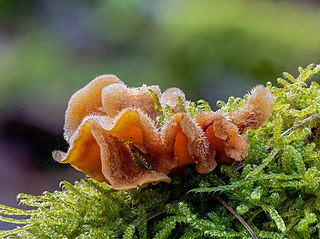
Stereum hirsutum, commonly known as the false turkey tail, hairy stereum, or hairy curtain crust, is a fungus typically forming multiple brackets on dead wood. It is also a plant pathogen infecting peach trees. S. hirsutum is in turn parasitised by certain other species such as the fungus Tremella aurantia. Substrates for S. hirsutum include dead limbs and trunks of both hardwoods and conifers.

Trametes gibbosa, commonly known as the lumpy bracket, is a polypore mushroom that causes white rot. It is found on beech stumps and the dead wood of other hardwood species. Fruit bodies are 8–15 cm in diameter and semicircular in shape. The upper surface is usually gray or white, but may be greenish in older specimens due to algal growth. Elongated pores are located on the under-surface. The fruiting bodies are frequently attacked by boring beetle larvae.

Crepidotus versutus, commonly known as the evasive agaric, is a species of fungus in the family Crepidotaceae. It is saprobic on wood, like other Crepidotus species, but it can also decompose herbaceous forest litter. The species is characterized by large, punctate, ellipsoid spores, and the white, hairy pileus.
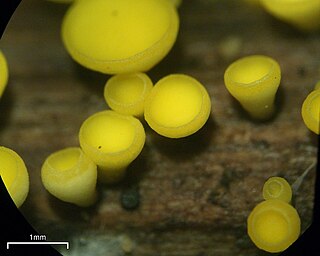
Bisporella citrina, commonly known as yellow fairy cups or lemon discos, is a species of fungus in the family Helotiaceae. The fungus produces tiny yellow cups up to 3 mm in diameter, often without stalks, that fruit in groups or dense clusters on decaying deciduous wood that has lost its bark. The widely distributed species is found in North Africa, Asia, Europe, North America, and Central and South America. Found in late summer and autumn, the fungus is fairly common, but is easily overlooked owing to its small size. There are several similar species that can in most cases be distinguished by differences in color, morphology, or substrate. Microscopically, B. citrina can be distinguished from these lookalikes by its elliptical spores, which have a central partition, and an oil drop at each end.

Exidia glandulosa, commonly known as black witches' butter, black jelly roll, or warty jelly fungus, is a jelly fungus in the family Auriculariaceae. It is a common, wood-rotting species in Europe, typically growing on dead attached branches of oak. The fruit bodies are up to 3 cm (1.2 in) wide, shiny, black and blister-like, and grow singly or in clusters. Its occurrence elsewhere is uncertain because of confusion with the related species, Exidia nigricans.

Butyriboletus appendiculatus is an edible pored mushroom that grows under oaks and other broad leaved trees such as beech. It is commonly known as the butter bolete. It often grows in large colonies beneath the oak trees, and is frequently found cohabiting with old oaks in ancient woodland. It is relatively rare in Britain. Its stipe and pores are often bright yellow and its flesh stains bright blue when cut or bruised.

Cantharellus lateritius, commonly known as the smooth chanterelle, is a species of edible fungus in the mushroom family Cantharellaceae. An ectomycorrhizal species, it is found in Asia, Africa, and North America. The species has a complex taxonomic history, and has undergone several name changes since its first description by American mycologist Lewis David de Schweinitz in 1822. The fruit bodies of the fungus are brightly colored yellow to orange, and usually highly conspicuous against the soil in which they are found. At maturity, the mushroom resembles a filled funnel with the spore-bearing surface along the sloping outer sides. The texture of the fertile undersurface (hymenium) of the caps is a distinguishing characteristic of the species: unlike the well-known golden chanterelle, the hymenium of C. lateritius is much smoother. Chemical analysis has revealed the presence of several carotenoid compounds in the fruit bodies.
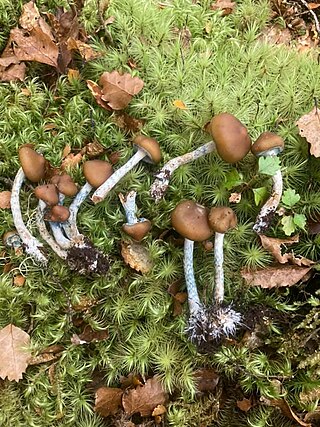
Psilocybe makarorae is a species of psilocybin mushroom in the family Hymenogastraceae. Officially described as new to science in 1995, it is known only from New Zealand, where it grows on rotting wood and twigs of southern beeches. The fruit body (mushroom) has a brownish cap with lighter coloured margins, measuring up to 3.5 cm (1.4 in) wide. The cap shape is either conical, bell-shaped, or flat depending on the age of the mushroom, and it features a prominent umbo. Although the whitish stem does not form a true ring, it retains remnants of the partial veil that covers and protects the gills of young fruit bodies. P. makarorae mushrooms can be distinguished from the similar North American species Psilocybe caerulipes by microscopic characteristics such as the presence of cystidia on the gill faces (pleurocystidia), and cheilocystidia with more elongated necks. Based on the bluing reaction to injury, P. makarorae is presumed to contain the psychedelic compounds psilocybin and psilocin.

The corticioid fungi are a group of fungi in the Basidiomycota typically having effused, smooth basidiocarps that are formed on the undersides of dead tree trunks or branches. They are sometimes colloquially called crust fungi or patch fungi. Originally such fungi were referred to the genus Corticium and subsequently to the family Corticiaceae, but it is now known that all corticioid species are not necessarily closely related. The fact that they look similar is an example of convergent evolution. Since they are often studied as a group, it is convenient to retain the informal (non-taxonomic) name of "corticioid fungi" and this term is frequently used in research papers and other texts.

Lactarius subflammeus, commonly known as the orange milk cap, is a species of fungus in the family Russulaceae. It is found in western North America in the late summer and fall and is especially common in the Pacific Northwest, where it grows on the ground near conifers like pine and spruce. The brightly colored fruit bodies, which are slimy or sticky, have scarlet caps when young that soon fade to brilliant orange. The stem—typically longer than the width of the cap—is also bright orange but the gills are whitish. The mushroom secretes a whitish latex when it is cut or injured.

Amanita nothofagi is a species of fungus in the family Amanitaceae. Endemic to New Zealand, the species was first described by mycologist Greta Stevenson in 1962. The fruit bodies have dark brown caps that are up to 13 cm (5.1 in) in diameter and covered with patches of soft greyish-brown scales or warts. The gills underneath the cap are crowded together, free from attachment to the stem, and white, becoming tinged with yellow in age. The stem of the mushroom is 4–14 cm (1.6–5.5 in) long by 0.5–2.5 cm (0.2–1.0 in) thick, and has a ring. The spore print is white, and individual spores are spherical to ellipsoid, measuring 7.5–9 by 7.5–9 micrometres. The mushroom may be confused with another New Zealand species, A. australis, but can be distinguished by certain characteristics. Amanita nothofagi is a mycorrhizal species, and grows in association with native New Zealand trees such as Southern Beech.

Cortinarius varius, also known as the contrary webcap, is a basidiomycete mushroom of the genus Cortinarius. The mushroom has orangish-yellow caps that reach up to 10 cm (3.9 in) in diameter, and thick club-shaped stems up to 10 cm (3.9 in) long.

Mycena stylobates, commonly known as the bulbous bonnet, is a species of inedible mushroom in the family Mycenaceae. Found in North America and Europe, it produces small whitish to gray fruit bodies with bell-shaped caps that are up to 15 mm (0.6 in) in diameter. The distinguishing characteristic of the mushroom is the fragile stipe, which is seated on a flat disk marked with distinct grooves, and fringed with a row of bristles. The mushrooms grow in small troops on leaves and other debris of deciduous and coniferous trees. The mushroom's spores are white in deposit, smooth, and ellipsoid-shaped with dimensions of 6–10 by 3.5–4.5 μm. In the development of the fruit body, the preliminary stipe and cap structures appear at the same time within the primordium, and hyphae originating from the stipe form a cover over the developing structures. The mycelia of the mushroom is believed to have bioluminescent properties.

Lactarius vinaceorufescens, commonly known as the yellow-staining milkcap or the yellow-latex milky, is a poisonous species of fungus in the family Russulaceae. It produces mushrooms with pinkish-cinnamon caps up to 12 cm (4.7 in) wide held by pinkish-white stems up to 7 cm (2.8 in) long. The closely spaced whitish to pinkish buff gills develop wine-red spots in age. When it is cut or injured, the mushroom oozes a white latex that rapidly turns bright sulfur-yellow. The species, common and widely distributed in North America, grows in the ground in association with conifer trees. There are several other Lactarius species that bear resemblance to L. vinaceorufescens, but most can be distinguished by differences in staining reactions, macroscopic characteristics, or habitat.
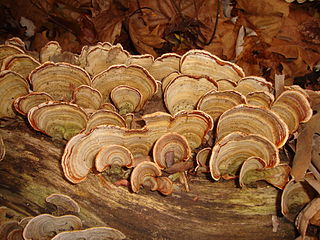
Stereum ostrea, also called false turkey-tail and golden curtain crust, is a basidiomycete fungus in the genus Stereum. It is a plant pathogen and a wood decay fungus. The name ostrea, from the word 'oyster', describes its shape. With concentric circles of many colors, it highly resembles Trametes versicolor, turkey-tail, and is thus called the 'false turkey-tail'. The stemless fruiting body is shell-like and grows 1–7 cm (0.39–2.76 in) high. It is tough and inedible. It grows on tree bark. This fungus is native to the island of Java, Indonesia and has been misapplied to the North American Stereum species Stereum fasciatum, Stereum lobatum, and Stereum subtomentosum.
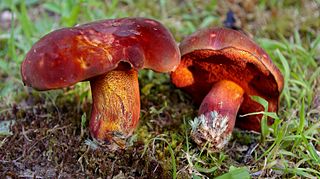
Boletus rubroflammeus is a species of bolete fungus in the family Boletaceae. First described from Michigan in 1971, it is found in the eastern United States and Mexico, where it grows in a mycorrhizal association with hardwood trees. The fruit bodies (mushrooms) of the fungus have caps that are deep red to purplish red, and dark red pores. The stem has coarse, dark red reticulations and a narrow yellow area at the top. All parts of the mushroom quickly stain blue when injured or cut. Lookalikes include Boletus flammans, a lighter-colored species that grows with conifers. Other similar species can be distinguished by differences in distribution, morphology, staining reaction, and microscopic characteristics. Boletus rubroflammeus mushrooms are poisonous, and can cause gastrointestinal distress if consumed.

Phaeocollybia christinae, commonly known as Christina's rootshank, is a species of fungus in the family Cortinariaceae. Found in the woodlands of Europe and eastern North America, it typically grows in sandy soil near conifer trees, especially spruce. The fruit bodies are characterized by a brownish cap with a pointed umbo, and a long stem that extends deeply into the soil.
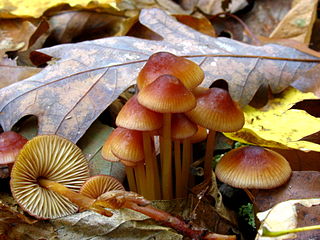
Mycena atkinsoniana is a species of agaric fungus in the family Mycenaceae. It is one of the so-called "bleeding mycenas" that will ooze yellow to orange juice when injured. Other distinguishing features include the upper stem surface that is decorated with tiny purplish-brown fibers, and the gills, which are pale yellow with maroon edges. The reddish-brown caps are smooth with a grooved margin, and up to 3 cm (1.2 in) wide. Mycena atkinsoniana is known from the United States and Canada, where it grows scattered or in groups on leaf litter in forests during the summer and autumn. It was originally described from collections associated with beech, but it is also frequently found under eastern North American oaks.
Stereum lobatum is a basidiomycete crust fungus, which means it does not have the traditional mushroom gills nor stem, but rather grows flat or with shelf-like protrusions on wood. The spores are produced on basidia, just like the gilled mushrooms, but instead of gills, the hymenophore directly houses the reproductive parts. In North America S. lobatum was long thought to be S. ostrea, but the recent accessibility to DNA sequencing has revealed that the two are distinct, and that S. ostrea is native to Indonesia and is not found in North America.



















